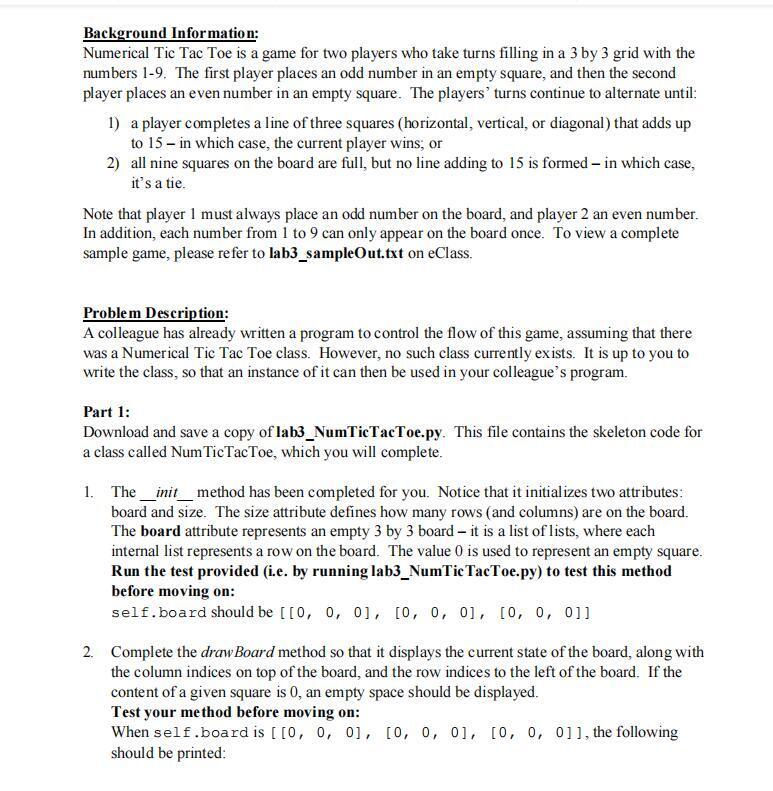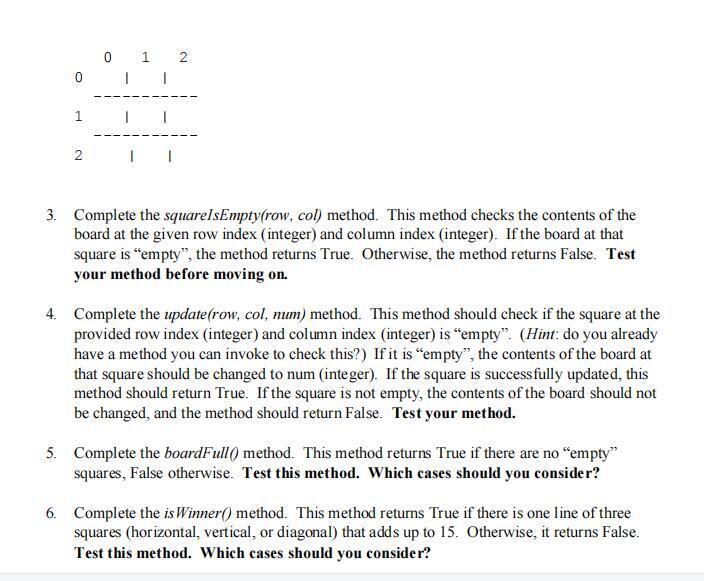Question
lab3_NumTicTacToe.py #---------------------------------------------------- # Lab 3: Numerical Tic Tac Toe class # # Author: # Collaborators: # References: #---------------------------------------------------- class NumTicTacToe: def __init__(self): ''' Initializes an


lab3_NumTicTacToe.py
#----------------------------------------------------
# Lab 3: Numerical Tic Tac Toe class
#
# Author:
# Collaborators:
# References:
#----------------------------------------------------
class NumTicTacToe:
def __init__(self):
'''
Initializes an empty Numerical Tic Tac Toe board.
Inputs: none
Returns: None
'''
self.board = [] # list of lists, where each internal list represents a row
self.size = 3 # number of columns and rows of board
# populate the empty squares in board with 0
for i in range(self.size):
row = []
for j in range(self.size):
row.append(0)
self.board.append(row)
def drawBoard(self):
'''
Displays the current state of the board, formatted with column and row
indicies shown.
Inputs: none
Returns: None
'''
# TO DO: delete pass and print out formatted board
# e.g. an empty board should look like this:
# 0 1 2
# 0 | |
# -----------
# 1 | |
# -----------
# 2 | |
pass
def squareIsEmpty(self, row, col):
'''
Checks if a given square is empty, or if it already contains a number
greater than 0.
Inputs:
row (int) - row index of square to check
col (int) - column index of square to check
Returns: True if square is empty; False otherwise
'''
# TO DO: delete pass and complete method
pass
def update(self, row, col, num):
'''
Assigns the integer, num, to the board at the provided row and column,
but only if that square is empty.
Inputs:
row (int) - row index of square to update
col (int) - column index of square to update
num (int) - entry to place in square
Returns: True if attempted update was successful; False otherwise
'''
# TO DO: delete pass and complete method
pass
def boardFull(self):
'''
Checks if the board has any remaining empty squares.
Inputs: none
Returns: True if the board has no empty squares (full); False otherwise
'''
# TO DO: delete pass and complete method
pass
def isWinner(self):
'''
Checks whether the current player has just made a winning move. In order
to win, the player must have just completed a line (of 3 squares) that
adds up to 15. That line can be horizontal, vertical, or diagonal.
Inputs: none
Returns: True if current player has won with their most recent move;
False otherwise
'''
# TO DO: delete pass and complete method
pass
if __name__ == "__main__":
# TEST EACH METHOD THOROUGHLY HERE
# suggested tests are provided as comments, but more tests may be required
# start by creating empty board and checking the contents of the board attribute
myBoard = NumTicTacToe()
print('Contents of board attribute when object first created:')
print(myBoard.board)
# does the empty board display properly?
myBoard.drawBoard()
# assign a number to an empty square and display
# try to assign a number to a non-empty square. What happens?
# check if the board has a winner. Should there be a winner after only 1 entry?
# check if the board is full. Should it be full after only 1 entry?
# add values to the board so that any line adds up to 15. Display
# check if the board has a winner
# check if the board is full
# write additional tests, as needed
Show transcribed image text
lab3_sampleOut.txt
--------------------------------------- Starting new Numerical Tic Tac Toe game ---------------------------------------
0 1 2 0 | | ----------- 1 | | ----------- 2 | | Player 1, please enter an odd number (1-9): 5 Player 1, please enter a row: 1 Player 1, please enter a column: 1
0 1 2 0 | | ----------- 1 | 5 | ----------- 2 | | Player 2, please enter an even number (2-8): 2 Player 2, please enter a row: 1 Player 2, please enter a column: 0
0 1 2 0 | | ----------- 1 2 | 5 | ----------- 2 | | Player 1, please enter an odd number (1-9): 1 Player 1, please enter a row: 0 Player 1, please enter a column: 2
0 1 2 0 | | 1 ----------- 1 2 | 5 | ----------- 2 | | Player 2, please enter an even number (2-8): 8 Player 2, please enter a row: 1 Player 2, please enter a column: 2
0 1 2 0 | | 1 ----------- 1 2 | 5 | 8 ----------- 2 | | Player 2 wins. Congrats! Do you want to play another game? (Y/N) n Thanks for playing! Goodbye.
Background Information: Numerical Tic Tac Toe is a game for two players who take turns filling in a 3 by 3 grid with the numbers 1-9. The first player places an odd number in an empty square, and then the second player places an even number in an empty square. The players' turns continue to alternate until: 1) a player completes a line of three squares (horizontal, vertical, or diagonal) that adds up to 15 - in which case, the current player wins; or 2) all nine squares on the board are full, but no line adding to 15 is formed - in which case, it's a tie. Note that player 1 must always place an odd number on the board, and player 2 an even number. In addition, each number from 1 to 9 can only appear on the board once. To view a complete sample game, please refer to lab3_sampleOut.txt on eClass Problem Description: A colleague has already written a program to control the flow of this game, assuming that there was a Numerical Tic Tac Toe class. However, no such class currently exists. It is up to you to write the class, so that an instance of it can then be used in your colleague's program. Part 1: Download and save a copy of lab3_NumTicTacToe.py. This file contains the skeleton code for a class called Num TicTacToe, which you will complete. 1. The __init_method has been completed for you. Notice that it initializes two attributes: board and size. The size attribute defines how many rows (and columns) are on the board. The board attribute represents an empty 3 by 3 board - it is a list of lists, where each internal list represents a row on the board. The value 0 is used to represent an empty square. Run the test provided (i.e. by running lab3_NumTic Tac Toe.py) to test this method before moving on: self.board should be [[0, 0, 0], [0, 0, 0], [0, 0, 0]] 2. Complete the draw Board method so that it displays the current state of the board, along with the column indices on top of the board, and the row indices to the left of the board. If the content of a given square is 0, an empty space should be displayed. Test your method before moving on: When self.board is [[0, 0, 0], [0, 0, 0], [0, 0, 0]], the following should be printed: 0 1 2. 0 1 1 N 3. Complete the squareIsEmpty(row, col) method. This method checks the contents of the board at the given row index (integer) and column index (integer). If the board at that square is "empty", the method returns True. Otherwise, the method returns False. Test your method before moving on. 4. Complete the update(row, col, num) method. This method should check if the square at the provided row index (integer) and column index (integer) is empty. (Hint: do you already have a method you can invoke to check this?) If it is "empty", the contents of the board at that square should be changed to num (integer). If the square is successfully updated, this method should return True. If the square is not empty, the contents of the board should not be changed, and the method should return False. Test your method. 5. Complete the boardFull() method. This method returns True if there are no "empty" squares, False otherwise. Test this method. Which cases should you consider? 6. Complete the is Winner() method. This method returns True if there is one line of three squares (horizontal, vertical, or diagonal) that adds up to 15. Otherwise, it returns False. Test this method. Which cases should you considerStep by Step Solution
There are 3 Steps involved in it
Step: 1

Get Instant Access to Expert-Tailored Solutions
See step-by-step solutions with expert insights and AI powered tools for academic success
Step: 2

Step: 3

Ace Your Homework with AI
Get the answers you need in no time with our AI-driven, step-by-step assistance
Get Started


